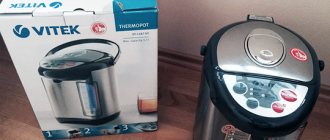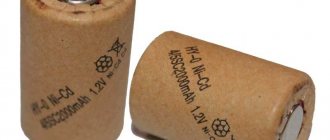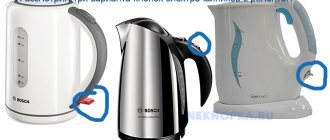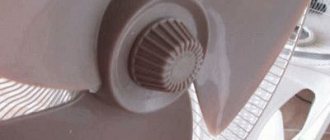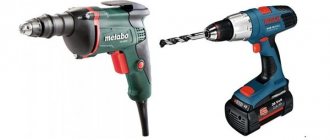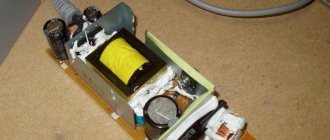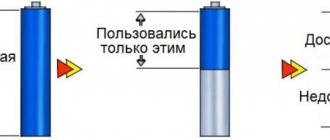A screwdriver is a fairly popular tool that greatly simplifies the process of screwing in and out of screws. Most of these tools operate on rechargeable batteries, which periodically fail. Many people who have encountered such a breakdown are interested in how to repair a battery for a screwdriver and what needs to be done for this.
A screwdriver is a tool that is often used in the household.
What you need to know before you start repairing a screwdriver battery
Before you try to restore the battery at home, you need to familiarize yourself with the basic recommendations:
- before starting repair work, it is necessary to determine the type of battery used;
- in the process of disassembling the battery case, it is necessary to find out the polarity of the connections;
- all “banks” installed in batteries to protect against overheating are equipped with a soldered resistor and therefore must be removed very carefully;
- Lithium-ion batteries cannot be repaired.
Additional Information! Almost all elements in Bosch, Interskol and Vikhr power tools have a serial connection.
Structural elements of a screwdriver
People who decide to repair a power tool should familiarize themselves with its main structural elements:
- Electrical engine;
- planetary gearbox for transmitting rotation from the motor to the spindle;
- a clutch that regulates torque;
- electronic control unit;
- battery;
- a clamping chuck with which the working attachments are secured.
If the screwdriver is used incorrectly, each of the listed components may fail.
Typical battery design
Regardless of the manufacturer and model, the screwdriver battery is a plastic case containing several batteries.
Connected screwdriver battery cans
The number of cans in the shell can vary from a few to a dozen pieces. Connected in series, the terminals of the first and last battery are closed, while providing connection to the charger. The supply voltage in household devices ranges from 9 to 18V. In some professional devices, the EMF value can reach up to 36V, which certainly affects the battery life.
In addition to the cans, the battery case may contain a temperature sensor and a thermal breaker, which serve to open the circuit in case of possible overheating of the device. Any rechargeable lithium-ion (Li-Ion) screwdriver battery is equipped with a special controller that ensures optimal discharge and operation of the batteries under load.
Types of screwdriver batteries
Currently, the most popular and in demand manufacturers of screwdrivers are the following types:
Nickel-cadmium batteries ( NiCd) .
Nickel-cadmium battery element for screwdriver
The cathode of this element is nickel hydrate with graphite powder and electrolyte. The anode is cadmium oxide hydrate Cd (OH)2. The electromotive force (EMF) of the battery is about 1.37V. Depending on the quality of the materials used and production technology, the service life of a nickel-cadmium screwdriver battery is about 15-25 years with an average number of charge-discharge cycles of 600 times.
The advantages of NiCd batteries include:
- durability. With proper operation, the period of normal operation of the battery can be 25 years;
— operation at low temperatures. Due to its chemical properties, the charge of this type of battery practically does not change with decreasing temperature, which makes it possible to use it in the harsh climate of our country;
- unpretentiousness at work;
— Possibility of storage in a state of discharge. Unlike other types of batteries, nickel-cadmium screwdriver batteries can be stored for a long time in a discharged state without reducing their properties;
- a large number of charge-discharge cycles.
The disadvantages of nickel-cadmium batteries are:
- memory effect. If the battery element is not completely discharged, it can “remember” the minimum charge level and, upon subsequent connection to the charger, will be filled with energy only up to this level;
- high specific gravity. With the same dimensions, the mass of a battery based on nickel hydrate and cadmium oxide will be significantly greater;
- problems with disposal. The high toxicity of the filling often causes problems with disposal.
Nickel metal hydride batteries (NiMH).
Nickel Metal Hydride Screwdriver Can
They are prominent representatives of alkaline batteries and belong to the group of chemical-type power sources. The cathode is nickel oxide (NiO), and the anode is a hydrogen metal hydride electrode. The initial emf of this type of battery is 8.4V, but over time it drops to 7.2V. Compared to nickel-cadmium NiMH batteries, they have 20% more capacity with an average number of discharge-charge cycles of 250 times.
Advantages of NiMH power supplies:
— high capacity with relatively small weight and dimensions;
- no memory effect. It is possible to not fully charge the battery and upon subsequent connections to the charger, the maximum capacity will be restored in the battery with a complete discharge during operation;
- environmental Safety. The fillers of nickel metal hydride screwdriver batteries are not hazardous to the environment and humans, and therefore do not require special disposal;
- resistance to damage. In case of strong impacts, NiMH battery banks are not destroyed and are able to operate as before.
Disadvantages of nickel-metal hydride batteries:
- high level of self-discharge. During long-term storage, the battery is greatly discharged and requires connection to a charger. To extend the life of the battery, it must be completely discharged and recharged;
— small number of charge cycles. Unlike nickel-cadmium batteries, the number of discharge-charge cycles for nickel-metal hydride batteries is only 250-500 times;
- “intolerance” to high temperatures. When the thermometer rises to 25 degrees Celsius, the battery loses its properties over time.
Lithium-ion batteries (Li-ion).
Lithium-ion screwdriver power supply
Batteries of this type are widely used in consumer electronics and energy storage systems and consist of a cathode on aluminum and an anode on copper foil separated by a porous separator. The charge carrier in such a battery is a charged lithium ion, which can be embedded in the crystal lattice of other materials (oxides, graphite, etc.). The nominal voltage is 3.7V, and the maximum is about 4.3V. With gradual discharge, the EMF drops to 2.5-3.0 Volts, depending on the capacity of the specific screwdriver battery model.
Advantages of lithium-ion screwdriver batteries:
— the ability to recharge at almost any stage of discharge without negative consequences in the future;
— complete absence of the “memory effect” inherent in nickel-cadmium batteries;
— absence of unsafe chemical elements;
— long service life (6-8 years);
— high charge power with relatively small dimensions;
— high speed of full charging.
Disadvantages of lithium-ion batteries (Li-ion):
- high cost;
— self-discharge at low temperatures;
— sensitivity to mechanical damage (shocks);
— intolerance to overcharging when fully charged.
Checking the screwdriver battery
Before you start repairing the tool, you need to familiarize yourself with the features of testing the battery.
Checking the battery for functionality
To make sure that the charger is working, you need to perform the following sequence of actions:
- Connect the unit to a power source.
- On the multimeter, turn on the DC current measurement mode.
- Connect the probes to the minus and plus of the charger.
- Review the results of the measurements taken.
If the values differ from the parameters located on the battery case, then you will have to repair it or buy a new one.
Checking battery capacity with a multimeter
Before repairing the battery, it is necessary to check its capacity. This is done like this:
- Fully charge the battery.
- Connect the multimeter probes to the battery contacts.
- Check the indicators on the device display.
If, after testing, the battery capacity is lower than declared, you will have to remove all batteries from the structure and test each of them.
Structural elements of a screwdriver
A screwdriver is rightfully considered an indispensable universal tool. The modern market of screwdrivers is represented by a large number of models equipped with batteries. Despite the variety of brands and modifications, all batteries have the same structure and only differ slightly from each other.
Each of them consists of individual elements connected in series with each other. All of them are made to standard sizes and have the same voltage level. Certain types of elements differ only in capacity, measured in A/h and indicated in the labeling.
The tool body contains 4 contacts that perform various functions. Including two are power ones, designed for charging and discharging. In addition, in the upper part there is a control contact included in the circuit along with a special temperature sensor. It protects the battery, cuts off the charging current and limits it to a set value by changing the temperature regime.
The fourth contact is located separately, connected together with a resistance. It is necessary when using highly complex charging stations capable of equalizing the charges of all battery cells. Such stations are rarely used in everyday life due to their high cost. A regular 12-volt screwdriver does not require such stations.
One of the reasons for the failure of a screwdriver is a malfunction of the battery, that is, its individual element. In such cases, when connected in series, the entire circuit fails.
Therefore, it is very important to accurately determine the faulty location. As a rule, this happens after the specified service life has expired.
This problem can be resolved in two ways: purchasing a new battery or repairing and restoring the old battery.
General recommendations before checking the battery
To properly test the battery, you need to familiarize yourself with the basic recommendations for testing different types of devices.
Nickel-cadmium
This is the most common type of battery. They are most often installed in screwdrivers from Bosch. Among the advantages of these batteries are their resistance to external influences and durability.
Before checking such batteries, they must be fully charged. This will allow you to obtain the most accurate measurements and ensure the functionality of the device. If you check a discharged battery, you will not be able to obtain accurate data.
Lithium-ion
Such batteries are most often installed in the most expensive models of power tools. They have a large capacity and a small percentage of loss of available charge. However, they also have a serious drawback, which is that they cannot be left discharged for a long time. The fact is that their crystals quickly degrade and because of this the battery stops working.
Before testing lithium-ion batteries, they must be fully charged and discharged three times. This is done to eliminate the “memory effect” and obtain the most accurate test results.
Replacing Nickel-Cadmium Batteries
Most inexpensive screwdrivers come with a nickel-cadmium battery. Such a battery is capable of operating at low temperatures without capacity loss and can withstand more than a thousand charge-discharge cycles. Moreover, the battery consists of toxic materials and does not tolerate deep discharge. To replace, just purchase new cans (it is not recommended to use used ones), open the case, and replace. If a drop in battery capacity is caused by a memory effect, to fix the problem there is no need to change the batteries; when the IP is charging, it is enough to apply a higher pulse current than the manufacturer recommends.
Repairing a screwdriver battery is a technically complex procedure that requires certain skills. If the owner is not confident in his abilities, it is recommended to entrust the battery restoration to specialists.
Common faults
Owners of screwdrivers who decide to repair the battery themselves should familiarize themselves with the most common types of faults. There are several reasons why batteries stop functioning normally:
- destruction of plates;
- short circuit;
- electrolyte contamination;
- reversal of poles;
- degradation of crystals due to long-term storage in a discharged state.
Additional Information! It is quite difficult to cope with the consequences of such breakdowns on your own. This is why many people decide to entrust battery repair to professionals.
How to determine if repair is possible
Before you repair a screwdriver battery at home, you need to figure out whether it is possible to repair it at all. To understand this, you will have to disassemble the power tool and carefully remove the battery “cans” from it.
The extracted cells must be sorted out and laid out in a row in front of you. After this, you need to check each element one by one with a multimeter. The voltage should be about 1.4 V. If on one of the components this value differs by 0.5 V up or down, then this element must be replaced. Therefore, such a battery can be repaired.
Adding distilled water
Restoring the battery of a screwdriver with topping up must be done with a completely discharged battery. Non-CD batteries are covered with paper. If there was evaporation, there will be noticeable marks on the surface.
After measuring the voltage, you need to completely discharge all the banks using a 12 volt light bulb. After this, the voltage is measured again. Those elements where it dropped to 0.7 are faulty.
To add distilled water, you need to make a hole in the side of the jar. A groove is made with a very thin drill (0.5-0.7 mm). You need to make sure that it doesn’t go inside and damage the plates.
A small amount of water is poured into a syringe with a thin needle. After this, the hole must be sealed with epoxy resin or sealant.
Now the battery can be pumped up. Each block must be discharged to zero again by connecting 1.5 volt light bulbs to them. When the procedure is completed, the battery is assembled and it is necessary to carry out 5 charging and discharging cycles.
List of required tools
To carry out repair work, you may need the following tools:
- Multimeter. This device is necessary for measuring AC and DC voltage.
- Curly and flat screwdrivers. Useful for disassembling the screwdriver body.
- Soldering iron. Inexpensive models with a power of about 40 W are suitable for repairs.
Additional Information! To use a soldering iron, you will need consumables such as solder and tin.
How to determine if a screwdriver battery is faulty
Determining a malfunction of a power tool is carried out as follows:
- Fully charge the battery.
- Disconnect the device from the network and remove the battery.
- Carry out a visual inspection and check for visible defects on the surface.
- Check the voltage of the “cans”.
- Connect a 24 V or 12 V car light bulb to the battery with wires.
- Turn off the lamp after 20-30 minutes and measure the voltage of the “cans” again.
If the capacity of the “cans” has sagged significantly, then they need to be replaced with new ones.
Screwdriver battery repair
Before you start repairing the battery yourself, you need to figure out how to do it correctly.
Disassembling the case
The battery case consists of two parts. Most often they are connected with screws. However, sometimes they are held together with superglue. In this case, the gluing areas should be carefully tapped with a mallet. After this, the glued parts will be much easier to separate.
Determination of defective cans
Identifying damaged “cans” is quite simple. To find them, you need to do the following:
- Conduct a visual inspection of the elements.
- Remove components with traces of swelling and particles of leaked electrolyte.
- Check the output voltage of each bank.
It is necessary to check components with a multimeter several times to obtain the most accurate measurement results.
Important! It is better to replace all banks whose voltage readings deviate greatly from the norm with new ones.
Recovering items
Anyone can restore battery “banks” on their own. This is done like this:
- Disassemble the battery and remove each component. It is impossible to charge all the cells well in a common battery.
- Apply a voltage of 3-4 V to each of the “cans” for five seconds.
- Measure the output voltage. If it is at 1.4 V, then the components have been restored.
Sometimes the above steps do not help restore the battery. In this case, you will have to replace it with a new one.
Battery assembly
When all components have been restored or replaced, the structure can be assembled. To do this, you need to install all the components back into the case. After this, the parts of the structure must be reconnected with screws or glue.
Battery recovery methods
On the Internet you can find advice on various methods of restoring elements of varying degrees of effectiveness and dubiousness. Immediately dismissing such unscientific methods as short-circuiting the battery terminals, you can consider several methods that make it possible to at least briefly extend the life of expensive power supplies.
Distilled water
If jars with zero voltage are found among the NiCd or NiMH battery cells, it can be assumed that their electrolyte has dried out. You can try to repair such an element by introducing distilled water. To do this, you need to drill a hole in the body and fill in about 1 ml of liquid with a syringe. The water should be absorbed. If this does not happen, the element cannot be restored. If the first portion is absorbed, further doses of water must be introduced until completely saturated, then the hole in the body must be sealed.
Injection of distilled water through a syringe.
Then you need to charge the element with a pulsed current (pulses with an amplitude of 10C lasting 2-4 seconds). If everything goes well, you need to let the jar sit for several hours and put it back into the battery.
Increased current
On the Internet you can find advice on how to revive a depleted screwdriver battery by charging it with high currents. The effectiveness of the method is questionable - the chances of the final loss of the element are higher than of its resuscitation. But restoring the capacity of NiMH or deeply discharged Li-Ion batteries through training can have a positive (but not very long-lasting) effect. To do this, you need to discharge the battery with a current approximately equal to C, then charge it. After repeating this cycle several times, it is often possible to restore the jar’s functionality for a while. In this case, you can discharge the elements into a light bulb.
Battery discharge for incandescent light bulbs during the training cycle.
Freezing
also very controversial and questionable . The battery is placed in a freezer with a temperature below minus 10 degrees C for several hours. Most experts consider this method wild. None of the advisers have yet given a clear explanation of what processes occur in the battery when frozen. But if other options have been exhausted, why not, to clear your conscience, try supercooling the battery before throwing it away.
Replacement of defective elements
Replacing a defective battery component is fairly easy. To do this, you need to get rid of the broken “can” by disconnecting it from the common plate with side cutters. A new component is then soldered to the ends of the contacts. After this, you need to check with a multimeter whether the installed element is working correctly.
The battery of a screwdriver is a part that often fails. If necessary, a broken battery can be repaired at home. However, before you do this, you need to figure out how to do it correctly.
What to do if the battery does not charge or does not hold a charge
It is known how to charge a screwdriver battery and how long to charge a screwdriver. What to do if nothing is charged? There are few reasons here. Something happened to the charger or the screwdriver itself is to blame. The battery itself may have expired. In any case, you need to inspect everything first.
The most common malfunction occurs when the terminals between the tool and the charger become unbent. Here the charger should be disassembled and the terminals returned to their original position. Metal elements on the battery and charger may oxidize. They get dust and dirt during operation.
The current flow is weak and the screwdriver does not charge well. The tool and battery should be looked after and protected from contamination whenever possible. Clean terminals and contacts regularly. If the battery itself fails, it is better to replace it.

